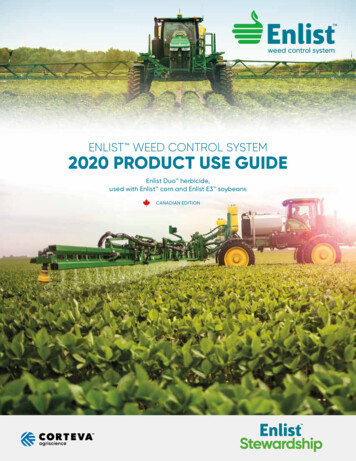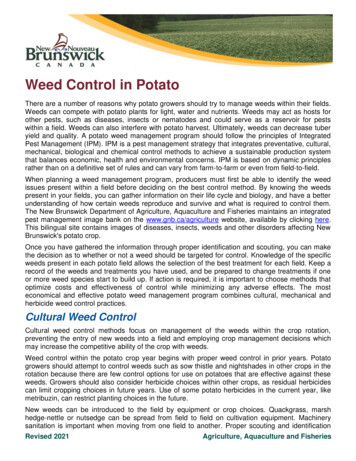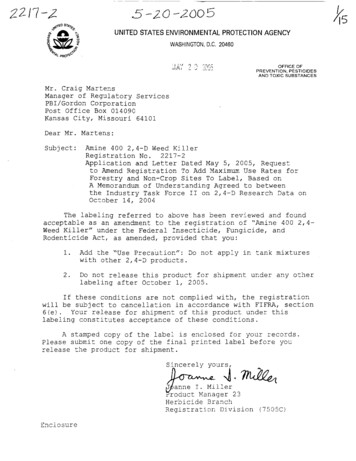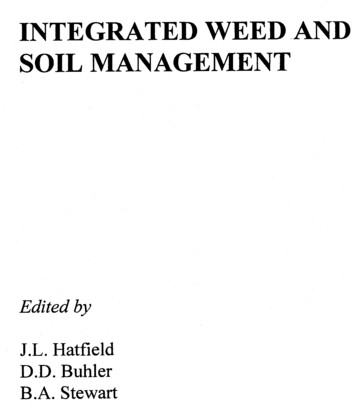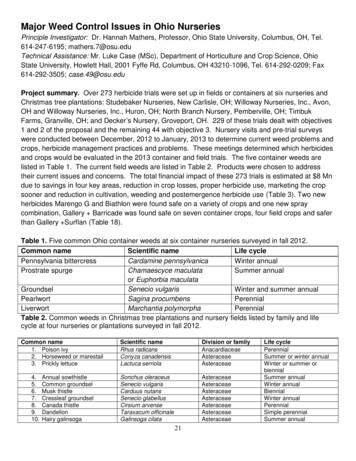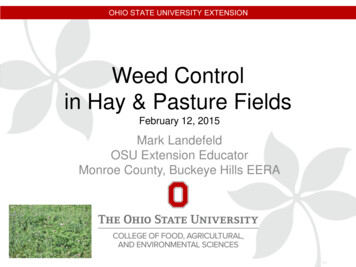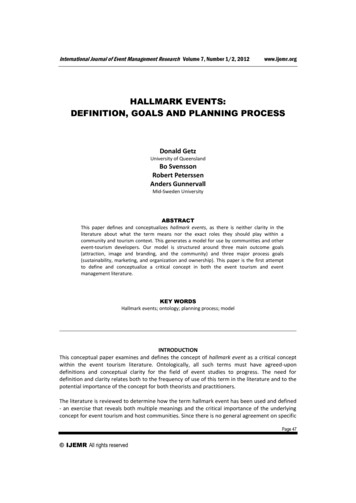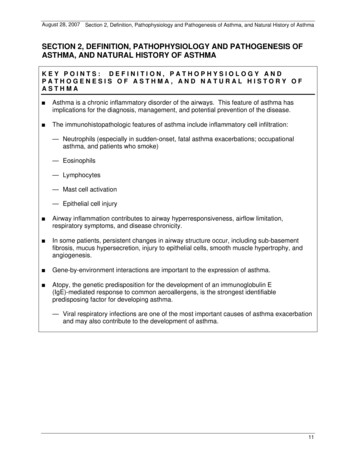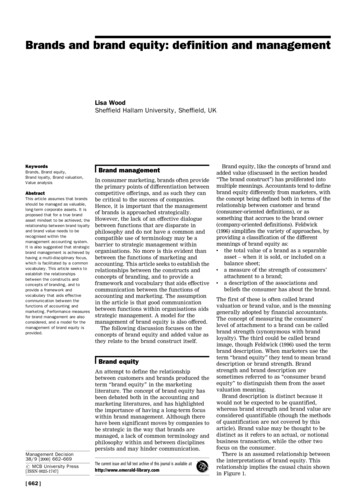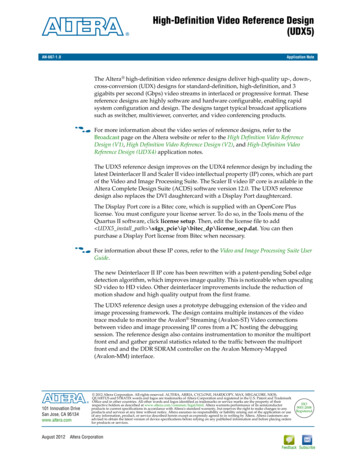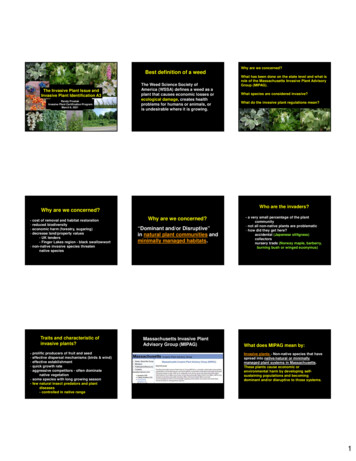
Transcription
Why are we concerned?Best definition of a weedThe Invasive Plant Issue andInvasive Plant Identification A3Randy ProstakInvasive Plant Certification ProgramMarch 8, 2021The Weed Science Society ofAmerica (WSSA) defines a weed as aplant that causes economic losses orecological damage, creates healthproblems for humans or animals, oris undesirable where it is growing.Traits and characteristic ofinvasive plants?- prolific producers of fruit and seed- effective dispersal mechanisms (birds & wind)- effective establishment- quick growth rate- aggressive competitors - often dominatenative vegetation- some species with long growing season- few natural insect predators and plantdiseases- controlled in native rangeWhat species are considered invasive?What do the invasive plant regulations mean?Who are the invaders?Why are we concerned?- cost of removal and habitat restoration- reduced biodiversity- economic harm (forestry, sugaring)- decrease land/property values- UK lenders- Finger Lakes region - black swallowwort- non-native invasive species threatennative speciesWhat has been done on the state level and what isrole of the Massachusetts Invasive Plant AdvisoryGroup (MIPAG).Why are we concerned?“Dominant and/or Disruptive”in natural plant communities andminimally managed habitats.Massachusetts Invasive PlantAdvisory Group (MIPAG)- a very small percentage of the plantcommunity- not all non-native plants are problematic- how did they get here?accidental (Japanese stiltgrass)collectorsnursery trade (Norway maple, barberry,burning bush or winged euonymus)What does MIPAG mean by:Invasive plants - Non-native species that havespread into native/natural or minimallymanaged plant systems in Massachusetts.These plants cause economic orenvironmental harm by developing selfsustaining populations and becomingdominant and/or disruptive to those systems.1
What does MIPAG mean by:Native or Indigenous species - A species thatoccurs natively in Massachusetts. Indigenousspecies often have a pre-colonial presence (pre1500) or have arrived in the region more recentlywithout the aid of human intervention.Non-native or Non-indigenous species - Aspecies that is not native or naturally occurring(based on its biology, phylogeny, distribution andcurrent knowledge about the species) withinMassachusetts. Can be indigenous to NorthAmerica but non-indigenous in Massachusetts.Habitats that play to role in theinvasive plant issue:1. Native/natural plant community (concern)2. Minimally managed habitats (concern)3. Intensively managed habitats (no of concern)Invasive plants - Non-native species that have spread intonative/natural or minimally managed plant systems inMassachusetts. These plants cause economic orenvironmental harm by developing self-sustainingpopulations and becoming dominant and/or disruptive tothose systems.What does MIPAG mean by:Native/natural plant community - A naturalplant community is an association orassemblage of plant species that repeatedlyoccur together in reoccurring patterns in aspecific type of habitat. This assemblage canbe characterized by dominant species andbiological properties. A natural plantcommunity implies a minimally managedsituation where all or most of the species thatmake up the assemblage are indigenous tothe defined area.What does MIPAG mean by:Minimally managed habitats - habitats wheremanagement efforts and investments of time,money and labor are infrequent or non-existent.These habitats may have been intensivelymanaged at one time in their history. In someinstances, management may be more intense,but management is done for conservationpurposes and is primarily aimed at preservingelements of biological diversity such asimperiled species or critical naturalcommunities.What does MIPAG mean by:Intensively managed habitats - habitats orland systems where management effortsand investments of time, money and laboroccur frequently. Examples includemanicured lawns, landscaped grounds,gardens, roadsides or agricultural landsfor crops or livestock.How did it all getstarted inMassachusetts?Do native plants get a pass?Should they?greenbrier, wild grape, poison ivyMassachusetts Invasive Plant Advisory Group (MIPAG)- formed in 1995 by the Ad Hoc Native PlantAdvisory Committee- to address the invasive plant issue in MA- recognized by the Massachusetts ExecutiveOffice of Environmental Affairs as part ofthe Massachusetts Council on InvasiveSpecies (coordinating mechanism forinvasive species management activitieswithin the Massachusetts)Dominant and/or Disruptive?2
Massachusetts Invasive Plant Advisory Group (MIPAG)- voluntary collaboration among public and privateorganizations concerned about the problemof invasive plants in Massachusetts- 16 to 18 entities are representedGROUPS REPRESENTED ON MIPAG: 3STATE AGENCIES- University of Massachusetts - Amherst- Massachusetts Department of Transportation- Massachusetts Department of Agricultural Resources- Massachusetts Natural Heritage and Endangered- Species Program in Massachusetts Division ofFisheries and Wildlife- Massachusetts Dept. of Conservation and Recreation- Division of Water Supply Protection- Areas of Critical Environmental ConcernFEDERAL AGENCIES- U.S. Fish and Wildlife Service- US Forest Service, US Department of AgricultureINVASIVEGROUPS REPRESENTED ON MIPAG: 1MIPAG members represent research institutions,non-profit organizations, the green industry, andstate and federal agenciesGREEN INDUSTRYNON-PROFIT ORGANIZATIONSNew England Nursery Association, now defunctMassachusetts Nursery and Landscape AssociationEcological Landscape AllianceAmericanHort, formerly American Nursery andLandscape Association- Native Plant Trust,formerly New England Wild Flower Society- The Nature Conservancy- The Trustees of Reservations- Massachusetts Association ofConservation Commissions, MACCTo evaluate plants for invasiveness:Step 1. MIPAG worked Les Mehrhoff, UConn- to adopt definitions* native and non-native species* minimally and intensively managed habitats- create a list of plant to be evaluated- develop a set of biologically-based criteria tobe used to evaluate invasivenessStep 2. MIPAG contracted with Les Mehrhoff- to gather data about selected species- help assess which currently are invasive orhave the potential to become problematicNorway maplebishop’s goutweedtree of heavengarlic mustardJapanese barberryoriental bittersweetblack swallow-wortautumn olivewinged euonymusglossy buckthornhorned sea poppydame’s rocket85 species were evaluated and identified asInvasive, Likely Invasive, or Potentially Invasive.Species in which sufficient information or evidenceis currently lacking for an adequate evaluation weredesignated as Do not list at this time.An annotated list of all species evaluated wasdeveloped.Step 3. Ongoing evaluation of new species and update oldINVASIVE33 of 8533 of 85Acer platanoidesAegopodium podagrariaAilanthus altissimaAlliaria petiolataBerberis thunbergiiCelastrus orbiculatusCynanchum louiseaeElaeagnus umbellataEuonymus alatusFrangula alnusGlaucium flavumHesperis matronalisGROUPS REPRESENTED ON MIPAG: 2MIPAG members represent research institutions, nonprofit organizations, the green industry, and state andfederal agencies.Iris pseudacorusLepidium latifoliumLonicera japonicaLysimachia nummulariaLythrum salicariaPhalaris arundinaceaPhragmites australisPolygonum cuspidatumRanunculus ficariaRhamnus catharticaRobinia pseudoacaciaRosa multifloraLIKELY INVASIVE29 of 85yellow iristall pepperweedJapanese honeysucklemoneywortpurple loosestrifereed canarygrasscommon reedJapanese knotweedlesser celandinecommon buckthornblack locustmultiflora roseAmpelopsis brevipedunculataBerberis vulgarisCynanchum rossicumEuphorbia cyparissiasLigustrum obtusifoliumLonicera tataricaMicrostegium vimineumMiscanthus sacchariflorusMyosotis scorpioidesRanunculus repensRubus phoenicolasiusSenecio jacobaeaTussilago farfaraporcelainberrycommon barberrypale swallow-wortcypress spurgeborder privettatarian honeysuckleJapanese stiltgrassamur silvergrassforget-me-notcreeping buttercupwineberrytansy ragwortcoltsfoot3
POTENTIALLY INVASIVE4 of 85Arthraxon hispidusCarex kobomugiLonicera maackiiPolygonum perfoliatumhairy joint grassJapanese sedgeamur honeysucklemile-a-minute vineNote: early in process Japanese stiltgrass was designatedto be POTENTIALLY INVASIVE, now INVASIVEMassachusetts Prohibited Plant ListMA General Law Chapter 128 Sec. 2 & 16 - 31A- MA Dept. of Agricultural Resources (MDAR), workedwith the MA Nursery and Landscape Association- effective January 1, 2006 limited the importation, sale, trade, and distributionand does not impact existing plantingsDO NOT LIST AT THIS TIME10 of 85Akebia quinataCatalpa speciosaCytisus scopariusElaeagnus angustifoliaLigustrum ovalifoliumLigustrum sinenseLigustrum vulgareMiscanthus sinensisPolygonum sachalinenseRosa rugosaVerbascum thapsusfive-leaved akebianorthern catalpascotch broomrussian oliveCalifornia privetChinese privetEuropean privetChinese silvergrassgiant knotweedrugosa rosecommon mulleinMassachusetts Prohibited Plant ListMA General Law Chapter 128 Sec. 2 & 16 - 31AMassachusetts Prohibited Plant ListMA General Law Chapter 128 Sec. 2 & 16 - 31Ahttp://www.mass.gov/agr/farmproducts/Prohibited Plant Index2.htmMassachusetts Prohibited Plant ListMA General Law Chapter 128 Sec. 2 & 16 - 31A“Herbaceous Exception species”“Woody Exception species”Importation - July 1, 2006 & Propagation - January 1, 2007Iris pseudacorusyellow IrisMiscanthus sacchariflorusamur silvergrassMyosotis scorpioidesforget-me-notImportation - July 1, 2006 & Propagation - January 1, 2009Acer platanoidesNorway mapleAcer pseudoplatanussycamore mapleBerberis thunbergiiJapanese barberryEuonymus alatuswinged euonymusLonicera japonicaJapanese honeysuckleLonicera maackiiAmur honeysuckleLonicera morrowiiMorrow’s honeysuckleLonicera tataricaTatarian honeysuckleLonicera x bellaBell’s honeysuckle- provides a “phase-out”: exception to minimize financialimpacts on MA ornamental nursery industry- “No-exception species”Importation Ban & Propagation Ban - January 1, 2006Massachusetts Prohibited Plant ListMA General Law Chapter 128 Sec. 2 & 16 - 31AHistory of EnforcementInspections for prohibited plants has become part ofMDAR’s annual retail nursery inspections“Sterile cultivar” issues1. what is sterility mean? Male orfemale? Level required?MDAR investigates all reports of illegal sales, manygeneral public2. product tracking and labellingconcernsIn 2006 and 2007, violators were asked either destroyto send back illegal nursery stock and stop-sale tosource nursery3. education to prevent market lagGreat resource for theidentification of invasiveplants in New England.In 2008, fines assessed, up to 50 per violation“Sterile cultivar” issue still open4
Websites for Invasive Plants inMassachusetts and New EnglandMassachusetts InvasivePlant Advisory GroupMassachusetts Invasive Plants Advisory Grouphttps://www.massnrc.org/mipag/Invasive Plant Atlas of New Englandwww.eddmaps.org/ipane/best way: web search IPANEwww.massnrc.org/mipag/MIPAG developed andoutlined invasive-plantmanagement objectives forthe Commonwealth inStrategic Recommendationsfor Managing Invasive Plantsin Massachusetts.- development of earlydetection and rapid responsesystem- research, management andeducation prioritieswww.massnrc.org/mipag/then click on “Publications”Early Detection and RapidResponse (EDRR) Sub-committeeEDRR is important because itattempts to manage invasiveplants in a region during theearliest stages of invasion.Guidance forthe EffectiveManagement ofInvasivePlants.More on thispublication inPart B.5
Regionalityof InvasivePlantsbutterfly bushBuddleja davidiibutterfly bushBuddleja davidiibutterfly bushBuddleja davidiiBut wait, it is native!!switchgrassPanicum virgatumswitchgrassPanicum virgatumswitchgrassPanicum virgatumSome Invasive Plantsin New England!!!switchgrassPanicum virgatumcommon reed or phragmitesPhragmites australis6
common reed or phragmitesPhragmites australiscommon reed or phragmitesPhragmites australiscommon reed or phragmitesPhragmites australisOften utilized as acool-season hayspecies in NewEngland.common reed or phragmitesPhragmites australisreed canarygrassPhalaris arundinaceareed canarygrassPhalaris arundinaceareed canarygrassPhalaris arundinaceareed canarygrassPhalaris arundinaceaamur silvergrassMiscanthus sacchariflorus7
amur silvergrassMiscanthus sacchariflorusamur silvergrassMiscanthus sacchariflorusamur silvergrassMiscanthus sacchariflorusChinese silvergrass(do not list at this time)Miscanthus sinensisChinese silvergrass(do not list at this time)Miscanthus sinensisamur silvergrassMiscanthus sacchariflorusChinese silvergrass(do not list at this time)Miscanthus sinensisChinese silvergrass(do not list at this time)Miscanthus sinensisChinese silvergrass(do not list at this time)Miscanthus sinensis8
Chinese silvergrass(do not list at this time)Miscanthus sinensisChinese silvergrass(do not list at this time)Miscanthus sinensisChinese silvergrass(do not list at this time)Miscanthus sinensisChinese silvergrass(do not list at this time)Miscanthus sinensisJapanese stiltgrassMicrostegium vimineumJapanese stiltgrassMicrostegium vimineumUnique because it is a C4 plant that is shade tolerant.Will become the “crabgrass of shaded turf”Japanese stiltgrassMicrostegium vimineumJapanese stiltgrassMicrostegium vimineumJapanese stiltgrassMicrostegium vimineum9
Japanese stiltgrass in Northwest New JerseyTHE NEW WORLDCapt. John SmithPocahontas,problem # 1: shewould havebeen10 years oldJapanese stiltgrassMicrostegium vimineumJapanese stiltgrassMicrostegium vimineumMovie: New WorldNotable for its attempt to be authentic:Movie: New WorldNotable for its attempt to be authentic:1. filmed on the Ckickahominy River, a tributary ofthe James River4. tools and materials related to geographical andtechnological environments of the settlement.2. actors trained by Blair Rudes, UNC-Charlotte, tospeak Powhatan language.5. sought out historic varieties of Indian corn andtobacco.3. archaeological evidence uses to reconstruct theJamestown settlement.HOWEVER, THERE ARE SOME PROBLEMS!!!TN 19191919 - 1607 312 years10
giant foxtail, US introduction: 19301930 - 1607 323 yearsJAPANESEKNOTWEEDJapanese knotweedPolygonum cuspidatumJapanese knotweedPolygonum cuspidatum11
JAPANESE KNOTWEEDNative to Japan & other parts of Asia,not MexicoJapanese knotweed is NOT a grass, it is abroadleaf in the knotweed orsmartweed family (Polygonaceae),same family as rhubarb and buckwheatJapanese knotweedPolygonum cuspidatumJapanese knotweedPolygonum cuspidatumJapanese knotweedPolygonum cuspidatumJapanese knotweedOther knotweed relatives:giant knotweed:- Polygonum sachalinense- Fallopia sachalinense- Reynoutria sachalinensegiant knotweedbohemian knotweed:- Fallopia bohemica, suspected hybid(P. cuspidatum & P. sachalinense)Note: increasingly more common in NEBohemian knotweedMeans of reproduction- asexually (primary): vegetativelypropagated by rhizomes- sexually: by seed, significantly lessimportant than vegetativepropagation by rhizomes- shredder leaf and stem material evenless significantgiant knotweedPolygonum sachalinensegiant knotweedPolygonum sachalinense12
Habitat- moisture or wet soils- often associated with wet areas- wetlands- stream & river corridors- forest edges- roadsides- abandon agricultural landgoutweed or bishop’s weedAegopodium podagrariagoutweed or bishop’s weedAegopodium podagrariagiant hogweed, Heracleum mantegazzianumGiant hogweed health concerns arise when thesap of these plants contacts your skin.The sap contains chemicals called psoralens(furocoumarins) that cause what dermatologists call"phytophotodermatitis."Phytophotodermatitis an inflammation (itis) of theskin (derm) induced by a plant (phyto) with the help ofsunlight (photo).When absorbed by skin, furocoumarins are energizedby UV light from the sun causing them to bind withnuclear DNA and cell membranes. This processdestroys cells and skin tissue.giant hogweed, Heracleum mantegazzianumGiant Hogweed(Heracleum mantegazzianum)Mild cases: affected skin reddens and feelssunburned.Severe cases: skin becomes red followed by blistersand for a period of time area will feels as if it hasbeen scalded. Often visible and permanent scaringoccurs after the blisters heal.Sensitive skin (arms, legs, torso, face, neck) are mostvulnerable. Moisture from perspiration speeds theabsorption of the psoralens.giant hogweed, Heracleum mantegazzianum13
giant hogweed,Heracleum mantegazzianumgiant hogweed, Heracleum mantegazzianumgiant hogweed, Heracleum mantegazzianumgarlic mustardAlliaria petiolatapurple loosestrifeLythrum salicariamoneywort or creeping JennieLysimachia nummulariagarlic mustardAlliaria petiolataNorway mapleAcer platanoidesNorway mapleAcer platanoides14
smooth sumacRhus glabrasmooth sumacRhus glabraNATIVENATIVEtree of heavenAilanthus altissimaNATIVEstaghorn sumacRhus typhinaNATIVEstaghorn sumacRhus typhinaNATIVEstaghorn sumacRhus typhinaNATIVEstaghorn sumacRhus typhinaBlack locustRobinia pseudoacaciaBlack locustRobinia pseudoacacia15
Japanese barberryBerberis thunbergiiautumn oliveElaeagnus umbellataburning bush or winged euonymusEuonymus alatusJapanese barberryBerberis thunbergiiburning bush or winged euonymusEuonymus alatusburning bush or winged euonymusEuonymus alatusautumn oliveElaeagnus umbellataburning bush or winged euonymusEuonymus alatusOriental bittersweetCelastrus orbiculatus16
Oriental bittersweetCelastrus orbiculatusAmerican bittersweetCelastrus scandensnon-nativeOriental bittersweetCelastrus orbiculatusOriental bittersweetCelastrus orbiculatus:- leaves round- flower and fruit axillarynativeAmerican bittersweetCelastrus scandens:- leaves ovate- flower and fruit terminalOriental BittersweetManagementDetermined by growthhabit:1. climbing vines2. shrubby ground cover- human activities:composting, soilmovement, disposalof fruit laden vines.- wildlife: bird andsmall mammals.A plant with staminate flowers and bisexual inone individual and pistillate flowers andbisexual flowers in other individual.Functionally dioecious some vines laden withfruit in fall and winter.Porcelain-berry, Ampelopsis brevipedunculataIs a woody vine.Seed dispersalPorcelain-berryAmpelopsis brevipedunculataJapanese honeysuckleLonicera japonica17
Japanese honeysuckleLonicera japonicaJapanese honeysuckleLonicera japonicamultiflora roseRosa multiflorapale swallowwortCynanchum rossicumpale swallowwortblack swallowwortCynanchum louiseaemultiflora roseRosa multifloraCynanchum rossicummile-a-minute weedPolygonum perfoliatum or Persicaria perfoliata18
mile-a-minute weedPolygonum perfoliatum or Persicaria perfoliatakudzuPueraria montanakudzuPueraria montanaAchnes of mile-a-minutekudzuPueraria montanaInvasive Plants and Implications forBio-fuel Crops in the USAWhat invasive plant species havebeen considered as a bio-fuel crop?What invasive plant species might beable to be used as a bio-fuel crop?common reed or phragmites (I)Phragmites australis19
Chinese silvergrass(do not list at this time)Miscanthus sinensisChinese silvergrass(do not list at this time)Miscanthus sinensisamur silvergrassMiscanthus saccharifloruswww.ifp.comgiant miscanthusMiscanthus x giganteusInvasive Plantsor a Lookalike?Oriental bittersweetCelastrus orbiculatusnon-nativeOriental bittersweetCelastrus orbiculatusOriental bittersweetCelastrus orbiculatusOriental bittersweetCelastrus orbiculatus:- leaves round- flower and fruit axillarynativeAmerican bittersweetCelastrus scandens:- leaves ovate- flower and fruit terminal20
porcelain-berryAmpelopsis brevipedunculatasame plant family (Vitaceae) at wild grapepale swallowwortCynanchum rossicumpale swallowwortCynanchum rossicumwinter habit ofswallowworthedge bindweed, Calystegia sepium,a swallowwort lookalikeblack swallowwortCynanchum louiseaefield bindweed, Convolvulus arvensis,a swallowwort lookalikeConvolvulaceae - Mo
Conservation Commissions, MACC GROUPS REPRESENTED ON MIPAG: 3 STATE AGENCIES - University of Massachusetts - Amherst - Massachusetts Department of Transportation . UNC-Charlotte, to speak Powhatan language. 3. archaeologic

